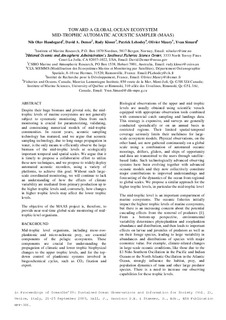Toward a Global Ocean Ecosystem Mid-trophic Automatic Acoustic Sampler (MAAS)
Handegard, Nils Olav; Demer, David A.; Kloser, Rudy; Lehodey, Patrick; Maury, Olivier; Simard, Yvard
Journal article, Peer reviewed
Permanent lenke
http://hdl.handle.net/11250/108294Utgivelsesdato
2009-05-26Metadata
Vis full innførselSamlinger
- Articles [3012]
Originalversjon
Handegard, N. & Co-Authors (2010). "Toward a Global Ocean Ecosystem Mid-Trophic Automatic Acoustic Sampler (MAAS)" in Proceedings of OceanObs’09: Sustained Ocean Observations and Information for Society (Vol. 2), Venice, Italy, 21-25 September 2009, Hall, J., Harrison, D.E. & Stammer, D., Eds., ESA Publication WPP-306, doi:10.5270/OceanObs09.cwp.40 http://dx.doi.org/10.5270/OceanObs09.cwp.40Sammendrag
Despite their huge biomass and pivotal role, the mid-trophic levels of marine ecosystems are not generally subject to systematic monitoring. Data from such monitoring is crucial for parameterizing, validating, and constraining numerical models of mid-trophic communities. In recent years, acoustic sampling technology has matured, and we argue that acoustic sampling technology, due to long-range propagation in water, is the only means to efficiently observe the large biomass of the mid-trophic levels at ecologically important temporal and spatial scales. We argue that it is timely to propose a collaborative effort to utilize these new techniques, and we propose to widely deploy automated acoustic recorders, using a variety of platforms, to achieve this goal. Without such large-scale coordinated monitoring, we will continue to lack an understanding of how the effects of climate variability are mediated from primary production up to the higher trophic levels and, conversely, how changes in higher trophic levels may affect the lower trophic levels. The objective of the MAAS project is, therefore, to provide near-real-time global-scale monitoring of mid-trophic-level organisms.
